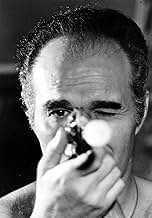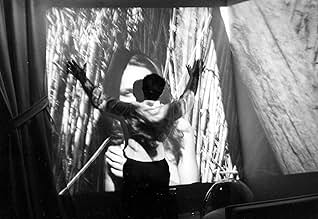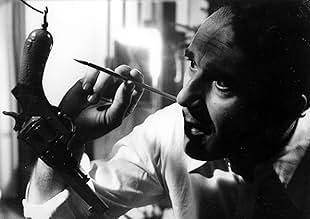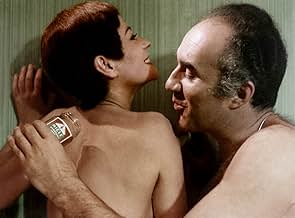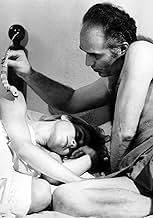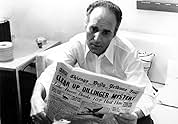IMDb-BEWERTUNG
6,9/10
2971
IHRE BEWERTUNG
Füge eine Handlung in deiner Sprache hinzuA man decides to cook for himself, but finds the revolver of John Dillinger hidden in his kitchen instead.A man decides to cook for himself, but finds the revolver of John Dillinger hidden in his kitchen instead.A man decides to cook for himself, but finds the revolver of John Dillinger hidden in his kitchen instead.
- Auszeichnungen
- 1 Gewinn & 2 Nominierungen insgesamt
Empfohlene Bewertungen
Ferreri is one of the most important filmmakers, of the greatful decade like 60 in italy. Like Fellini or Pasolini, the director turn the movie in a dreamly journey to the fears and fantasies of the audience. The initial trip, when Piccoli drive a car, and the transformation of guns in art objects are very disquieting. An subversive idea. But, the most amazing is the influence of an old newspaper (the title is: Dillinger is dead)in the attitude of the protagonist. Phoenomenon similar to Lynch's inexplicable possessions. The first step for being seduced by Ferreri´s images.
Wealthy, middle-aged gas-mask maker Michel Piccoli (as Glauco) arrives home late from work and finds his beautiful blonde wife in bed with a headache. While she blows kisses to her goldfish, Mr. Piccoli rejects the dinner she left and decides to make a hot gourmet meal. Gathering ingredients, Mr. Piccoli opens a closet door and some poorly-stacked newspapers fall out onto the floor. Restacking the items, Piccoli finds an unexpected object wrapped in a newspaper containing an article on the death of 1930s US gangster John Dillinger. This is where director Marco Ferreri derives "Dillinger Is Dead" as a title. Piccoli is intrigued by his newspaper discovery and it ends up changing his life...
Mr. Ferreri and Piccoli appear to be having fun with this arty film. They may have been having a little too much fun. It starts out with some rather explicit references to a theme. You could call it "the alienation of modern man," and Ferreri does appear to be naming that as his thesis. Later, it veers perilously close to a mid-life crisis. The protagonist is difficult to identify with; possibly, he's too bourgeois. Some scenes move as slow as molasses or, as you'll see, honey. A "finger dance" segment enlivens an otherwise dull portion; it's pointless, but that's what fingers do. This viewer narrowed it down to two options for Glauco, considering his discovery. Not sure he made the best choice.
****** Dillinger Is Dead (1/23/1969) Marco Ferreri ~ Michel Piccoli, Annie Girardot, Anita Pallenberg, Gino Lavagetto
Mr. Ferreri and Piccoli appear to be having fun with this arty film. They may have been having a little too much fun. It starts out with some rather explicit references to a theme. You could call it "the alienation of modern man," and Ferreri does appear to be naming that as his thesis. Later, it veers perilously close to a mid-life crisis. The protagonist is difficult to identify with; possibly, he's too bourgeois. Some scenes move as slow as molasses or, as you'll see, honey. A "finger dance" segment enlivens an otherwise dull portion; it's pointless, but that's what fingers do. This viewer narrowed it down to two options for Glauco, considering his discovery. Not sure he made the best choice.
****** Dillinger Is Dead (1/23/1969) Marco Ferreri ~ Michel Piccoli, Annie Girardot, Anita Pallenberg, Gino Lavagetto
In pop-culture, 1969 was a year of extremes. In August we experienced the very peaceful mass-event of Woodstock, and in December a black guy was killed during a Rolling Stones-concert. Thereafter the magic of the 1960s vanished.
Coincidence or not, 'Dillinger è morto' clearly reflects this sharp bend in the public appreciation of those days. Showing a glittering performance by male lead Michel Piccoli -- assisted by a credible role for Annie Girardot, all in Ferreri's good picturing.
The third lead in this film is Anita Pallenberg. She depends more on her looks than on her acting. And also lending a decadent touch to 'Dillinger è morto', in 1969 Pallenberg was reputed as the love-girl of three Rolling Stones ...
Coincidence or not, 'Dillinger è morto' clearly reflects this sharp bend in the public appreciation of those days. Showing a glittering performance by male lead Michel Piccoli -- assisted by a credible role for Annie Girardot, all in Ferreri's good picturing.
The third lead in this film is Anita Pallenberg. She depends more on her looks than on her acting. And also lending a decadent touch to 'Dillinger è morto', in 1969 Pallenberg was reputed as the love-girl of three Rolling Stones ...
A well-off industrial designer, Glauco, comes back home and sees his wife who allegedly has a headache and rests in bed. She leaves him a cold dinner, lest Glauco should feel hungry. Nevertheless, Glauco chooses to prepare the meal on his own. While cooking, he discloses a gun wrapped in a newspaper which recounts events regarding a famous mobster Dillinger's demise
Whilst reading this paragraph, one is likely to scratch his head and reassure this is what the movie is genuinely about. This is no mistake – Dillinger is Dead is precisely a product of its time. A bold, weird and mesmerizingly original film which has more in common with existentialism and fantasy than Dillinger himself. The concept of merging reality with surrealism and transmuting it into an artistic manifestation is indubitably exquisite. Straightforwardly speaking, the story by Ferreri is an infant of sheer uniqueness and it stimulates one's senses. Despite the fact that the whole motion picture is virtually filmed solely in Glauco's apartment, Ferreri aptly lunges the plot and it consequently never drags or feels rushed. The characters existent in the flick sporadically encounter one another and the action generally revolves around Glauco. Neither does one get to know his past, nor his views on the outer world. Yet, his mental state is absolutely precise and visible inasmuch his soul is diaphanous owing to Ferreri's fantastic mise-en-scène which visualises Glauco's existential ennui by exposing his disparate acts in his home which serve totally nothing. The protagonist seems nearly a phantom creeping through ensuing chambers of his apartment. He desperately endeavours to do something, satisfy himself anyhow, still he is at a loss for options. His behaviour perpetuated on the celluloid consists of most probably his everyday activities. This enchantingly articulates the meaninglessness and pointlessness of his life. What is new in his life is the weapon wrapped in the mysterious newspaper which inscrutably appears in his apartment. Once he finds the gun, he gradually embarks on altering his life and this is the onset of his transformation which leads to the abrupt and outré denouement.
Mario Vulpiani's cinematography captures the infertility of Glauco's actions in an eye-pleasing manner and it's occasionally ravishing and co-operates with the soundtrack by Teo Usuelli duly. The performance by Michel Piccoli is very good, resembling his appearances in Bunuel movies in which he plays analogous roles. His minimalistic attitude is very appropriate and renders the character plausible.
While portraying existential ennui wasn't something ground-breaking and refreshing in 1969, what strikes in case of Dillinger is Dead is Ferreri's atypical execution of the material. Apart from being structurally quite precisely delineated and recounted, it's far from being a film reminiscent of Edward Munch's painting The Scream or Antonioni flicks. What one might behold here is a huge irony, enormous portions of dark humour and hilarious wickedness. Given that Ferreri was a leftist, it may be analysed as criticism of bourgeois class – filled with money, yet incapable of spending it on laudable aims or developing their interests since there are not such for them. Hence, the movie works well as a wicked depiction of pointlessness of human in modern society as well as a political and satirical manifesto. No matter how sophisticatedly one approaches Dillinger is Dead, it is a highly riveting piece of cinematographic extravaganza which ought to appeal to those seeking for something else and lovers of the sixties or art-house cinema, whereas all others should make allowances for the possibility that this slow-paced, somewhat plot less quirk might be emotionally insufficient and boring as well as possibly exasperating for some.
Whilst reading this paragraph, one is likely to scratch his head and reassure this is what the movie is genuinely about. This is no mistake – Dillinger is Dead is precisely a product of its time. A bold, weird and mesmerizingly original film which has more in common with existentialism and fantasy than Dillinger himself. The concept of merging reality with surrealism and transmuting it into an artistic manifestation is indubitably exquisite. Straightforwardly speaking, the story by Ferreri is an infant of sheer uniqueness and it stimulates one's senses. Despite the fact that the whole motion picture is virtually filmed solely in Glauco's apartment, Ferreri aptly lunges the plot and it consequently never drags or feels rushed. The characters existent in the flick sporadically encounter one another and the action generally revolves around Glauco. Neither does one get to know his past, nor his views on the outer world. Yet, his mental state is absolutely precise and visible inasmuch his soul is diaphanous owing to Ferreri's fantastic mise-en-scène which visualises Glauco's existential ennui by exposing his disparate acts in his home which serve totally nothing. The protagonist seems nearly a phantom creeping through ensuing chambers of his apartment. He desperately endeavours to do something, satisfy himself anyhow, still he is at a loss for options. His behaviour perpetuated on the celluloid consists of most probably his everyday activities. This enchantingly articulates the meaninglessness and pointlessness of his life. What is new in his life is the weapon wrapped in the mysterious newspaper which inscrutably appears in his apartment. Once he finds the gun, he gradually embarks on altering his life and this is the onset of his transformation which leads to the abrupt and outré denouement.
Mario Vulpiani's cinematography captures the infertility of Glauco's actions in an eye-pleasing manner and it's occasionally ravishing and co-operates with the soundtrack by Teo Usuelli duly. The performance by Michel Piccoli is very good, resembling his appearances in Bunuel movies in which he plays analogous roles. His minimalistic attitude is very appropriate and renders the character plausible.
While portraying existential ennui wasn't something ground-breaking and refreshing in 1969, what strikes in case of Dillinger is Dead is Ferreri's atypical execution of the material. Apart from being structurally quite precisely delineated and recounted, it's far from being a film reminiscent of Edward Munch's painting The Scream or Antonioni flicks. What one might behold here is a huge irony, enormous portions of dark humour and hilarious wickedness. Given that Ferreri was a leftist, it may be analysed as criticism of bourgeois class – filled with money, yet incapable of spending it on laudable aims or developing their interests since there are not such for them. Hence, the movie works well as a wicked depiction of pointlessness of human in modern society as well as a political and satirical manifesto. No matter how sophisticatedly one approaches Dillinger is Dead, it is a highly riveting piece of cinematographic extravaganza which ought to appeal to those seeking for something else and lovers of the sixties or art-house cinema, whereas all others should make allowances for the possibility that this slow-paced, somewhat plot less quirk might be emotionally insufficient and boring as well as possibly exasperating for some.
Although idiosyncratic and decidedly off beat, Marco Ferreri realised the importance of star names and following the international success of this, his first film to feature Michel Piccoli, the actors who entrusted themselves to his direction were not only extremely talented but like Piccoli were not afraid to push the boundaries and take chances. Of course Piccoli's inherent quirkiness makes him ideal casting whilst the emphasis in this on mundane domestic activity might be tedious were it not for his mesmerising performance.
As an avowed communist Ferreri's films became even more anarchic as time went on but here the anarchy is more controlled and is essentially a study in alienation, the entrapment of Marriage and the way in which so-called technological advances merely serve to repress the human spirit.
Anton Chekhov's maxim that once a gun is introduced it must at some stage inevitably go off is realised to devastating effect here and the low-key, almost clinical way in which the weapon is eventually used still shocks fifty years on.
Piccoli is supported by the equally quirky and courageous Annie Girardot as his obliging maid and as his wife the delectable Anita Pallenburg who has been used on the poster as the film's 'come on'.
This director's most famous (and infamous) opus is 'La Grande Bouffe' but there are many who consider this earlier work to be his greatest achievement.
Looking at Ferreri's depictions of urban angst calls to mind Thoreau's 'The mass of men lead lives of quiet desperation.'
As an avowed communist Ferreri's films became even more anarchic as time went on but here the anarchy is more controlled and is essentially a study in alienation, the entrapment of Marriage and the way in which so-called technological advances merely serve to repress the human spirit.
Anton Chekhov's maxim that once a gun is introduced it must at some stage inevitably go off is realised to devastating effect here and the low-key, almost clinical way in which the weapon is eventually used still shocks fifty years on.
Piccoli is supported by the equally quirky and courageous Annie Girardot as his obliging maid and as his wife the delectable Anita Pallenburg who has been used on the poster as the film's 'come on'.
This director's most famous (and infamous) opus is 'La Grande Bouffe' but there are many who consider this earlier work to be his greatest achievement.
Looking at Ferreri's depictions of urban angst calls to mind Thoreau's 'The mass of men lead lives of quiet desperation.'
Wusstest du schon
- WissenswertesThe interiors shown in the film are almost entirely those of the apartment once belonged to Italian Postmodern artist Mario Schifano. Some of his paintings can be seen hanging on the walls of the house. The kitchen scenes were shot into a country villa belonged to actor Ugo Tognazzi, good friend with director Marco Ferreri and frequently cast in his films.
- PatzerHe is 'cooking' in an empty saucepan; the spatula is clean and dry.
- VerbindungenEdited into Spisok korabley (2008)
Top-Auswahl
Melde dich zum Bewerten an und greife auf die Watchlist für personalisierte Empfehlungen zu.
- How long is Dillinger Is Dead?Powered by Alexa
Details
- Laufzeit1 Stunde 35 Minuten
- Sound-Mix
- Seitenverhältnis
- 1.37 : 1
Zu dieser Seite beitragen
Bearbeitung vorschlagen oder fehlenden Inhalt hinzufügen



